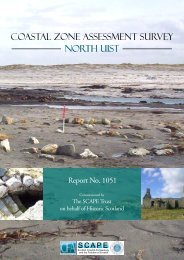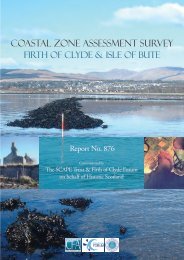COASTAL ZONE ASSESSMENT SURVEY - SCAPE
COASTAL ZONE ASSESSMENT SURVEY - SCAPE
COASTAL ZONE ASSESSMENT SURVEY - SCAPE
Create successful ePaper yourself
Turn your PDF publications into a flip-book with our unique Google optimized e-Paper software.
• Areas experiencing relative sea level rise are becoming progressively<br />
more susceptible to the effects of storm surge activity. However it is<br />
noted that this will vary according to exposure.<br />
• The impact of sea surface rise will be less noticeable in areas with a strong<br />
sediment supply and where coastal progradation is taking place, for<br />
example the Moray Firth coastline, parts of the north east and east of<br />
Scotland, parts of northern Scotland and parts of south-west Scotland. In<br />
areas where sediment supply is scarce, the effect of a sea surface rise will<br />
be more noticeable.<br />
• In areas where the coastal features are easily eroded, the impact of sea<br />
level rise will have greater effect than in other, more resistant areas.<br />
3.3.3 The results of Dawson et al. (2001) were based on the uplift data of Shennan<br />
(1989) together with the UK Climate Impacts Programme (UKCIP) emissions<br />
scenario that envisages that most of the projected sea level rise in the next<br />
century will be as a result of thermal expansion. Their data shows that the<br />
study area lies within Zone B where intermediate rates of uplift are predicted<br />
at c. 0.5-1.00mm per annum (Figure 2). Their “best estimate” for the next 50<br />
years is a predicted rise of around 16cm, and by the year 2100 a rise of 31.5cm<br />
is predicted. However they provide a cautionary statement that their sea level<br />
return period analyses are not linked to patterns of storminess change derived<br />
from the analyses of the North Atlantic Oscillation Index and other empirical<br />
storm data. These authors rightly note that storm frequency will be a major<br />
causative factor in relative sea level change in the short term.<br />
3.3.4 Increases in recent storm frequency have been a central point in assessing the<br />
vulnerability of the Scottish coastline, particularly where ‘softer’ sediment<br />
forms a main component of a given coastal cell. Its location in relation to<br />
direct wave impact during the tidal cycle will have a bearing on the relative<br />
rates of recession and in some cases, if conditions are right, on accretion.<br />
Previous coastal zone assessment surveys already undertaken on behalf of<br />
Historic Scotland have highlighted the vulnerability of the softer regions of the<br />
Scottish coastline and the effects of storm activity that has, and continues to<br />
have, an effect on coastal archaeology. Cressey and Toolis 1997and Cressey<br />
et al 2001 showed that within parts of the Solway Firth, cliffs containing softer<br />
sediment, including marine clay and loosely consolidated materials such as<br />
shingle and sand, were extremely vulnerable to rapid coastal erosion. This<br />
was especially bad in areas where building refuse had been dumped in<br />
attempts to slow down cliff recession. It was found that during high spring<br />
tides these areas were badly affected by excessive scouring and abrasion as the<br />
dump material was hammered against the base of the soft cliffs.<br />
3.3.5 The enclosed nature of the Firth of Clyde with its narrow system of fjords<br />
severely limits the wave field affecting the coastline of this area. As a result<br />
the height and direction of waves reaching the coast are highly dependent on<br />
the wind direction (Firth and Collins 2002). Both sections of coastline within<br />
the study area display the effect of wind direction. The south coast of Arran is<br />
directly affected by winds derived from the south-west sector. Although<br />
KACL/997/0<br />
15<br />
CFA









